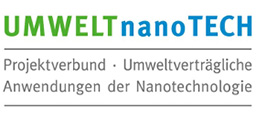UMWELTnanoTECH
ENVIRONMENTALLY COMPATIBLE APPLICATIONS OF NANOTECHNOLOGY

5 Printing technologies for thermoelectric generators
Field of work:
ThermoelectricityThe task
In order to meet the challenges our society will face in the coming years and decades, CO2-neutral methods and the ability to save resources in industry and in households are the top priority.
The goal of this project is to create prototypes of printed thermoelectric generators (TEG) for the conversion of thermal energy from ambient heat into electric energy. The target application area for operating temperatures is from 50 °C – 60 °C and with temperature differences of up to 40 Kelvin. The application potentials of TEG's of this type are in sensor technology as well as in autonomous microsystems and other low-power applications.
Results after the first project year
After conducting the planned literature research and market analysis, successful printing tests have been carried out using the selected organic PEDOT:PSS in a paste form (intrinsically conducting polymer) in combination with silver printing paste. Initial thermoelectric generators have already been implemented on the flexible basic substrates polyimide (PI) and polyethylene terephthalate (PET). A combination of screen printing and the jet process is used as printing process, although the transition to strictly digital, tool-free printing processes is desirable. In the flexible jet process, the material is applied onto the substrate contact-free via a nozzle with a piezo element or via an electro-pneumatically piston.
The printing materials were printed in Meander form onto substrate materials according to the following figure. The green legs correspond to the PEDOT:PSS, the black legs correspond to the printed Ag paste. For test purposes, TEG layouts were initially implemented with one, two and three thermal pairs. An extension to several hundred pairs in series is feasible with regard to the printing technology.
After drying the material pairs, they were placed between the heat sink and the heat source of the setup which was established during the course of the project and the open circuit voltages of the thermal pairs were determined. With an increasing temperature difference, the open circuit voltage increases accordingly. With a temperature difference of 30 K, for example, it is possible to create a voltage of approx. 1 mV for 3 thermal pairs. With a difference of around 65 K, more than 2 mV were measured. In addition, the results show that, with a multiplication of the thermal pairs connected in series, the open circuit voltage can be increased accordingly.
Summary
During the previous project period it could be proven that the results of investigations are very promising. It can be expected that an increase in the number of serially connected thermal pairs with simultaneous improvement of the material properties through modification with CNTs, for example, will result in considerably higher voltages. Further processing according to the project plan should give final information about whether the affordable and flexible production of prototypes of TEGs can be implemented for microsystems in this way.



